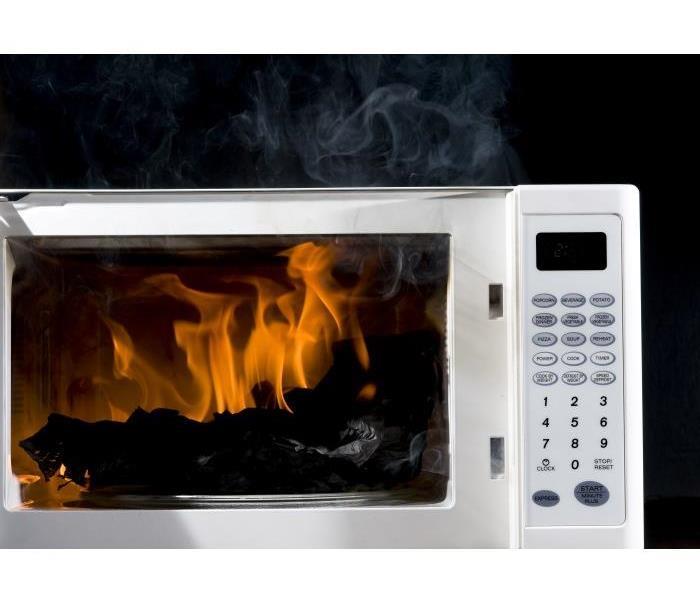Common Causes For Fire Damage
11/19/2021 (Permalink)
Most people are aware of the fire risks posed by candles, smoking, and malfunctioning appliances, but there are also a number of everyday household hazards that may surprise you. Below are some of the most commonly overlooked sources of house fires.
Microwaves
Microwaves - especially out-of-date models - are one of the most common sources of house fires. Accidentally microwaving a piece of silverware or aluminum foil can cause arcing, and dry foods can easily ignite if cooked for too long. To make matters worse, the fan can also provide oxygen to feed the flames, which is why you should never leave a microwave unattended when in use.
Batteries
While battery-related fires are rare, they do happen. 9-volt batteries are especially hazardous, since the positive and negative posts are so close together. If a piece of conductive metal comes between those posts, it could cause a short, igniting any nearby combustible materials. The best option is to store unused batteries in their original packaging, or to cover the ends with a bit of electrical tape. Never store batteries in a drawer with loose metal or flammable objects.
Light Bulbs
All outlets are rated for a certain wattage, and use light bulbs that exceed those standards is a fire waiting to happen. If the outlet is unmarked, the safest course of action is to choose light bulbs that are 60 watts or below. If your home includes track or recessed lighting, consider using cooler LED bulbs instead of CFLs in order to avoid overheating.
Dryer Lint
Every year, more than 15,000 fires are caused by dryer lint. Lint traps do not catch the majority of lint, which means that most of it ends up in the dryer vents, blocking air flow and exhaust gasses and eventually becoming a serious fire hazard. Clean the lint trap between each load of laundry, and take the time to clear lint away from the vent and the back of the dryer at least once a month.
Laptops
Laptops heat up during regular use, and covering up their cooling vents can result in overheating and even a fire. Avoid leaving your laptop on the bed, couch, or any other surface that might block air flow.
Reading Materials
Newspapers, magazines, books, and paperwork can easily ignite if stored too close to a heat source. Always store reading materials on a shelf or in another cool, dry place, and consider tossing out anything that you won't use again so that it doesn't become a hazard in the future.
Heating Pads
Heating pads and electrical blankets that are old, damaged, or improperly used can pose a significant risk to your home and your safety. Replace any pads that have missing covers, tears, cracks, or exposed wires. Avoid bunching pads up during use, and never fall asleep with a heating pad turned on - many older models do not have an auto-off setting, which can lead to serious burns, short-outs, and even fires.
Charcoal
Barbecue charcoal is highly flammable, even when it's damp. The best way to store charcoal is to keep it inside a metal container with an air-tight lid, so that if a fire does start, it won't be able to spread. Keep charcoal in an area that isn't exposed to sunlight or moisture, such as a shed or outdoor storage unit.
Clutter
Assorted clutter is a surprisingly common source of household fires. Combustible materials that are stored near light fixtures or electrical outlets can easily ignite; clutter in the bedroom is especially dangerous since it gives you less time to react to a potential fire. Avoid stacking clothing or paperwork in a closet with light bulbs, and vacuum regularly so that flammable dust doesn't accumulate around sockets and light fixtures.
Old Appliances
Old and outdated appliances are a major fire hazard, even if appear to be functioning properly. Many older appliances do not have the built-in safety features that come with modern models, and pieces may wear out or break down over time with regular use. Check old appliances regularly for worn insulation, exposed wiring, or malfunctioning components.






 24/7 Emergency Service
24/7 Emergency Service
